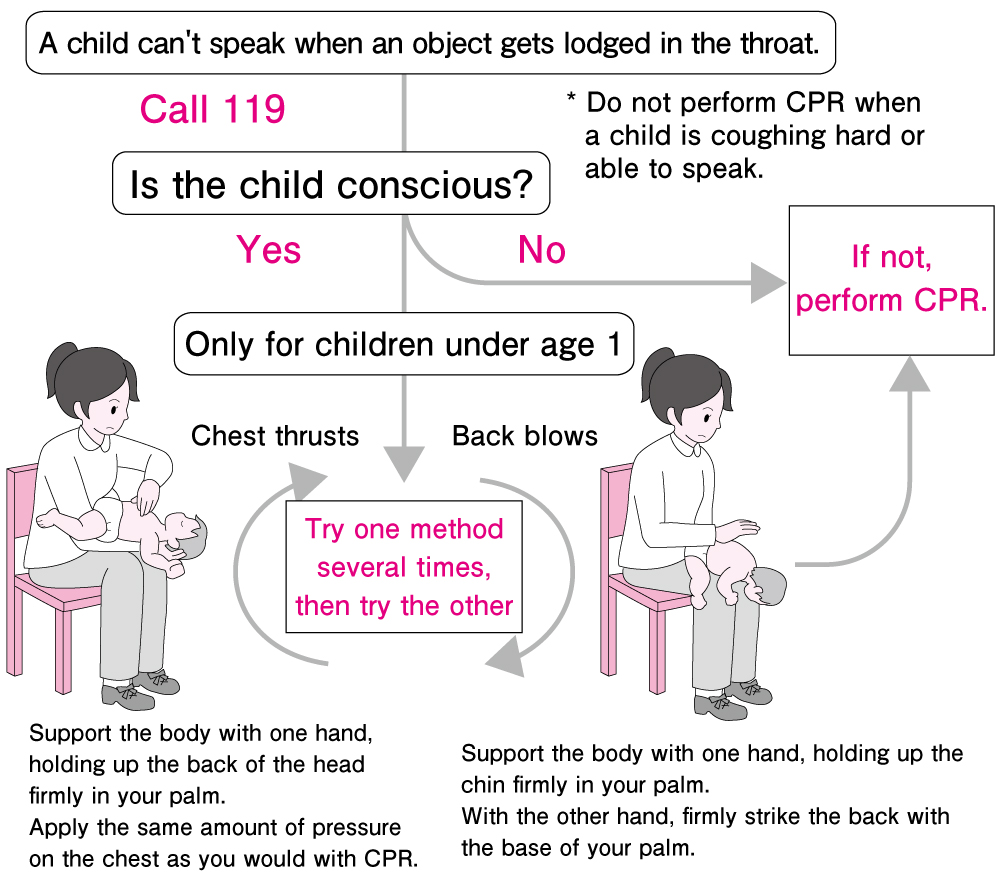First-aid for when food, a toy or other object becomes lodged in the throat
【食べ物や玩具など、ものがのどにつまった時の応急手当】
A baby or toddler will put things in the mouth that an adult would not. If food, a toy or other object becomes lodged in the throat, there is a risk of suffocation.
乳幼児は、大人が思いもよらないものを口にします。食べ物や玩具等がのどにつまると、窒息する危険があります。
Adults around your child should know about what size of object is normally prone to becoming stuck in a baby or toddler's mouth. (At three years of age, the mouth is up to 39 mm wide and the distance from the mouth to the back of the throat is 51 mm ) Carefully check any warnings about handling food or toys. You must also know in advance how to administer first-aid so that you can respond promptly.
周囲の大人が、普段から乳幼児ののどに詰まりやすい大きさの目安(3歳児の最大口径39mm、口から喉の奥までの長さ51mm)を知り、窒息につながりやすい食べ物の注意点や玩具の取り扱いに関する注意書きをよく確認するとともに、すぐに対処できるように、応急手当について知っておくことが必要です。
If you stick your finger in the mouth to remove the object, the foreign matter could move even deeper inside.
口の中に指を入れて取り出そうとすると、異物がさらに奥へ進んでしまうことがあります。
* Information on puncture wounds with a toothbrush
※歯ブラシの喉つき事故についての情報
Leaflet "Build a Better Brushing Teeth Routine" (Japanese Society of Pediatric Dentistry)
「楽しく安全に歯みがきをする習慣を身につけよう」リーフレット(日本小児歯科学会)
https://www.jspd.or.jp/common/pdf/hamigaki_a.pdf
https://www.jspd.or.jp/common/pdf/hamigaki_b.pdf
First-Aid for When an Object Gets Lodged in the Throat
【ものがのどにつまった時の応急処置】

* Only for childrenage 1 and up
(※)1歳以上の幼児
Use instead of chest thrusts and back blows.
胸部突き上げ法や背部叩打法の代わりに行います
Abdominal thrusts (a.k.a. the Heimlich maneuver)
腹部突き上げ法(ハイムリック法)
Wrap both arms around the torso from behind and, while holding one hand below the pit of the stomach,
背後から両腕を回し、子どものみぞおちの下で片方の手を握り拳にします。
squeeze on the child's belly.
その手を腹部を上方へ圧迫しましょう。
Continue until you remove the foreign object or paramedics arrive and take over.
異物が取れるか、救急隊と交替するまで繰り返し続けましょう
(Supervision) Japanese Society of Pediatric Pulmonology, Japan Emergency Care Foundation CPR Committee
(監修)日本小児呼吸器学会、日本小児救急医学会
How to Perform CPR
【心肺蘇生法】
The basics of cardio-pulmonary resuscitation (CPR) are compressions and artificial respiration. Even just performing artificial respiration is a courageous act that could save a child's life.
心肺蘇生法の基本は、胸骨圧迫と人工呼吸です。胸骨圧迫だけでも、人工呼吸だけでも、何かをするその勇気がお子さんの救命につながります。
If you think there is something wrong with your child, call out for help and commence CPR according to the steps provided below.
様子がおかしいと思ったら助けを呼んで、以下の心肺蘇生法の手順を開始しましょう。

Continue until the child starts crying or paramedics arrive and take over.
泣き出すか、救急隊と交替するまで続けましょう
Make sure to perform CPR on a hard floor.
*心肺蘇生法はなるべく固い床の上で行いましょう
(Supervision) Japanese Society of Pediatric Pulmonology, Japan Emergency Care Foundation CPR Committee
(監修)日本小児呼吸器学会、日本小児救急医学会
* Fire departments and other institutions provide classes on first-aid. It's a good idea to take a class because you will be able to act more calmly in an emergency once you are used to the procedure.
※消防機関等で応急処置の講習会が行われています。慣れておくと安心なので、参加してみましょう。
